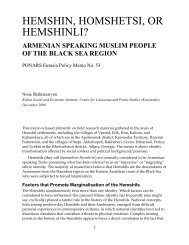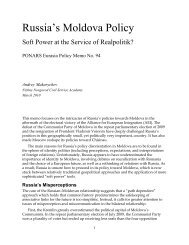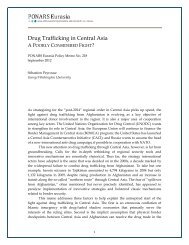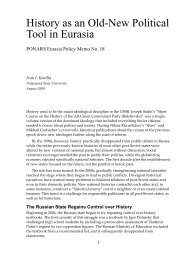View the Policy Memo (PDF) - PONARS Eurasia
View the Policy Memo (PDF) - PONARS Eurasia
View the Policy Memo (PDF) - PONARS Eurasia
You also want an ePaper? Increase the reach of your titles
YUMPU automatically turns print PDFs into web optimized ePapers that Google loves.
The Boston marathon bombings are commonly described as a case of ei<strong>the</strong>r<br />
“leaderless resistance” or ”lone wolf” terrorism (or both). While <strong>the</strong>se two concepts are<br />
at times used interchangeably, <strong>the</strong>y generally differ in regards to <strong>the</strong> main type of actor.<br />
“Leaderless resistance” mainly refers to terrorism as a network strategy and<br />
organizational pattern consciously adopted, often under pressure, by loose networks of<br />
cells and individuals to streng<strong>the</strong>n asymmetrical advantages vis-à-vis hierarchicallystructured<br />
opponents. “Lone wolf” terrorism implies attacks by stand-alone individuals<br />
or cells acting independently from any group or network. It is not surprising that <strong>the</strong><br />
two phenomena are often confused in cases such as <strong>the</strong> Boston bombings. This is partly<br />
due to a lack of information about a cell’s links in <strong>the</strong> early stages of an investigation,<br />
but it is also due to <strong>the</strong> particular difficulties of establishing <strong>the</strong> nature and connections<br />
of someone who acts outside a formal organizational framework and lacks traditional<br />
leads associated with <strong>the</strong> latter. In part, this confusion results from a genuine overlap<br />
between “leaderless resistance” and “lone wolf” terrorism, especially in <strong>the</strong> global<br />
jihadist movement.<br />
While today “leaderless resistance” is commonly associated with <strong>the</strong> global<br />
jihadist movement, <strong>the</strong> concept was originally developed by <strong>the</strong> extreme right in <strong>the</strong> late<br />
1980s and early 1990s. What its godfa<strong>the</strong>r, U.S. white supremacist Louis Beam, had in<br />
mind were very flat networks, with a complete absence of top-down authority. 1<br />
“Leaderless resistance” was defined as a matter of conscious organizational choice in<br />
favor of a strategy that “allows for and encourages individuals or small cells to engage<br />
in acts of political violence entirely independent of any hierarchy of leadership…” 2<br />
While Beam’s original concept encompassed “lone wolf” attacks by stand-alone<br />
individuals (and applies to high-profile acts of right-wing terrorism, such as <strong>the</strong><br />
Oklahoma City and <strong>the</strong> Atlanta bombings in <strong>the</strong> United States in <strong>the</strong> mid-1990s, as well<br />
as <strong>the</strong> 2011 Oslo attacks), his main hopes were vested in a multiple-cell leaderless<br />
structure—hopes that never materialized for <strong>the</strong> far right.<br />
The concept of a multiple-cell leaderless movement has been more successfully<br />
applied by radical environmentalists, notably <strong>the</strong> Earth Liberation Front (ELF). With no<br />
centralized organization, leadership, or membership roll, ELF violence has been less<br />
deadly than mass-casualty attacks by stand-alone right-wing terrorists, but <strong>the</strong> network<br />
emphasizes sabotage, resulting in heavy property damage, and has achieved a high<br />
frequency of attacks (100 per year on average in <strong>the</strong> late 1990s and early 2000s). The<br />
concept is also sometimes applied retrospectively to anarchists as a highly decentralized<br />
movement built upon semi-autonomous cells and voluntary associations. While acts of<br />
anarchist terrorism (including high-profile political assassinations in <strong>the</strong> past) often<br />
resulted from spontaneous individual actions with <strong>the</strong> help of a few friends, “leaderless<br />
resistance” should only be projected onto that movement with care; for anarchists <strong>the</strong><br />
“leaderless” impulse was not inherently linked to violence in <strong>the</strong> first place but reflected<br />
<strong>the</strong>ir general strategic, organizational, and ideological preferences.<br />
1 Louis Beam, “Leaderless Resistance,” The Seditionist, No. 12, 1992.<br />
2 Paul Joosse, “Leaderless Resistance and Ideological Inclusion: The Case of <strong>the</strong> Earth Liberation Front,”<br />
Terrorism and Political Violence 19 (2007): 351-368.<br />
2










